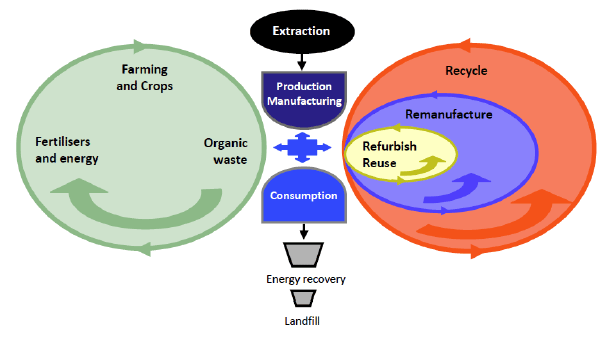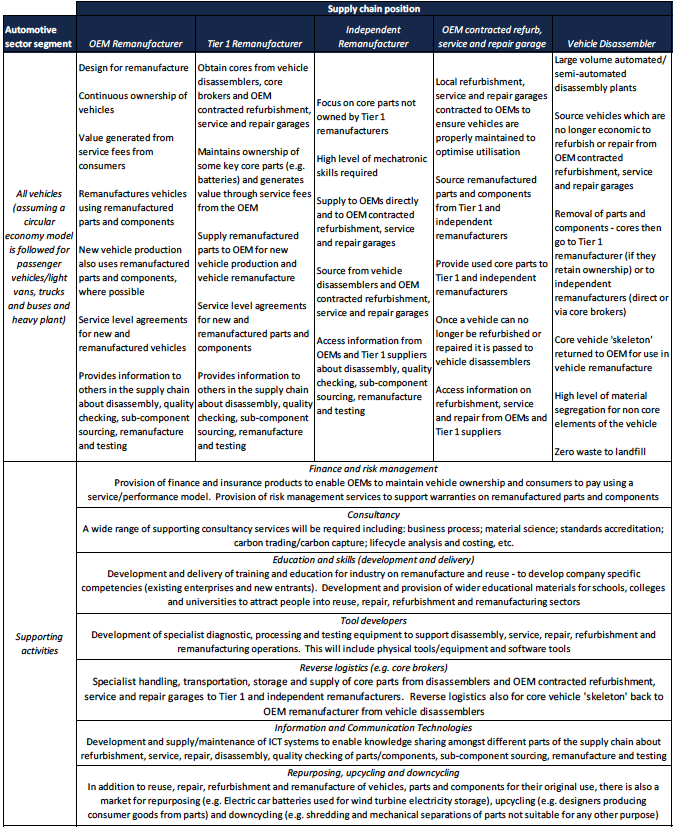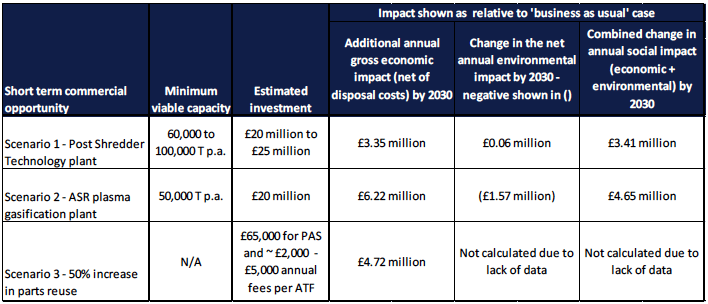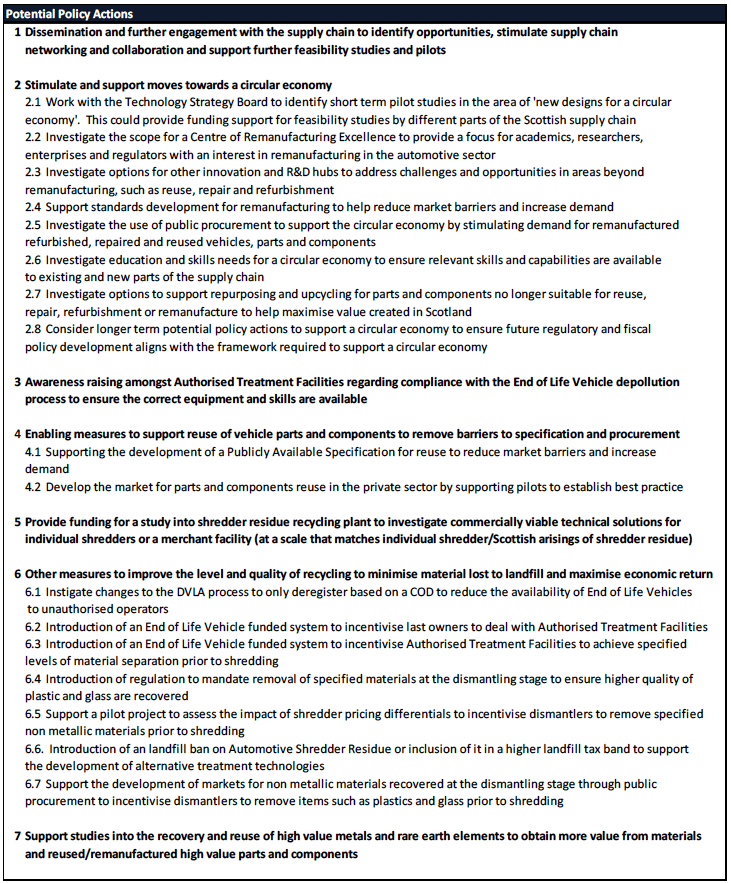Remanufacture, refurbishment, reuse and recycling of vehicles: trends and opportunities
This report describes the short, medium and long term trends related to the remanufacturing, refurbishment, reuse and recycling of vehicles, parts and components in Scotland.
Executive Summary
The automotive sector plays an important role in the Scottish economy, despite the lack of passenger vehicle production facilities. Vehicle production continues to be a feature of the Scottish economy in the bus and heavy plant sectors with supporting supply chains. A large number of people are also employed in vehicle sales, service and repair. There are a number of examples of companies that remanufacture and refurbish vehicle parts, such as automatic transmissions and engines. At the end of life of the vehicle, dismantling, parts reuse and material recycling enterprises also contribute value and employment to the Scottish economy.
Long and short term trends faced by the automotive sector
The automotive sector is a significant user of materials and energy in production. Similar to other production sectors, it faces considerable challenges arising from a growing global population which is expected to increase from six billion people today to around nine billion by 2050. In addition to the growth in overall population numbers it is also predicted that consumption per person will increase as developing nations become richer. The combination of these two trends will result in greater demand for resources and subsequent price increases and issues with security of supply (of both energy and scarce materials).
The issue of increasing energy use (with the obvious link to fossil fuel use and resulting carbon dioxide emissions) and broader increasing pressure on finite resources is attracting interest from governments, business and civil society around the world. This is resulting in new policies and regulation relating to resource efficiency and climate change. There is also evidence of businesses taking action to address these strategic challenges and some consumers changing their buying behaviour.
Technological change will also result in vehicles becoming ever more complex, with a shift from mechanical parts to increasingly hybrid mechanical/electronic (mechatronic) parts. These will have higher residual values, meaning the economic case for reuse, repair, refurbishment and remanufacture improves against the alternative of material recycling.
In addition to these longer term trends, the passenger vehicle and light van sector also faces short term challenges associated with meeting (2015) reuse and recovery targets set by the End of Life Vehicle Directive.
Medium to long term opportunities for the Scottish economy
A range of opportunities for enterprises and the wider Scottish economy are possible, through a shift in the current 'linear economic model' to a 'circular economic model'. In the context of a vehicle, a 'linear economic model' describes where material is extracted, converted to parts and components then assembled to be used by the consumer until it reaches end of life. It is then disposed of (with the majority of material being recycled, displacing further extraction but still requiring energy in future production processes). A 'circular economic model' describes a situation where the material is kept in use by the market as parts and components for a much longer period and more value obtained from it. This reduces both the rate of raw material extraction and the energy used to convert raw materials into functional parts and components. Parts and components are reused, repaired, refurbished and remanufactured. The decision about which process to use depends on several factors including safety, performance and the economic case. The speed with which parts and components return to the market (and are therefore utilised and generate value) and the energy used in the process, differs between reuse, repair, refurbishment and remanufacture.
Figure 1, below, compares and summarises the alternative linear and circular material flows.

Figure 1 - Linear and circular flows of material [1]
Moving to a circular model of material flow is recognised by many leading industrial countries as a potential source of competitive advantage. For example, China, United States and Singapore all have (or intend to introduce) either high level policy commitments and/or research centres of excellence in this area.
A recent report has highlighted the automotive sector as being the largest beneficiary of total net material cost savings of between USD 340 billion - 630 billion per year. This cost saving is predicted to be made, by a range of complex durable products with medium life-spans, through a shift to an economic model where material is circulated in the manner described above [2] .
Figure 2, below, simplifies and summarises the wide range of potential opportunities to generate value and create skilled employment opportunities in Scotland.

Figure 2 - Potential automotive supply chain based on a circular economy model
This research report identifies a number of opportunities which would be present in such future supply chain, including:
1. Development of refurbishment, service and repair operations at the vehicle level
2. Development of remanufacturing operations at the part, component and sub-component level
3. Development of large scale, semi-automated, disassembly plants for vehicles no longer suitable for refurbishment, repair and service
4. Development of services around financial instruments to support different business models
5. Development of numerous consultancy services including business process engineering, material science services, standards accreditation, carbon trading/carbon capture
6. Development and delivery of education and skills training aimed at schools, colleges, universities and businesses
7. Development of specialist diagnostic, processing and testing equipment to support disassembly, service, repair, refurbishment and remanufacturing operations
8. Development of reverse logistics services taking into account concerns over the increasing need for safe handling, storage and transportation of parts and components with increasing electronic composition
9. Development and maintenance of ICT systems for information sharing between different parts of the supply chain about vehicle and part design, disassembly, quality checking, sub-component sourcing, remanufacture and testing
10. Development of enterprises established to repurpose vehicle components and parts ( e.g. electric batteries to renewable energy storage uses)
11. Development of enterprises engaged in upcycling of vehicle parts and components ( e.g. artists and designers producing consumer goods)
12. Development of downcycling operations with greater expertise in material recovery ( e.g. extraction of rare earth elements from magnetic components)
Each part of the potential future automotive supply chain is described in greater detail in section seven along with further discussion on the areas of opportunity.
Short term challenges faced by dismantlers and shredders
In addition to the medium to long term trends and challenges faced by the wider automotive sector, this research report highlights the short term challenges faced by parts of the sector involved in reuse and recycling of parts and components (vehicle dismantlers and shredders).
There are around 140 registered end of life vehicle dismantlers (or Authorised Treatment Facilities) based in Scotland and four large mechanical shredders. These enterprises are estimated to process a minimum of 100,000 end of life vehicles per annum, in addition to other metal containing products, such as waste electrical and electronic equipment. Some of these dismantlers work with compliance schemes operated on behalf of passenger and light van producers and importers to report on performance against targets set within the End of Life Vehicle Directive. Section three provides more details about the relevant legislation and market structure.
The End of Life Vehicle Directive has set a target of 85% reuse and recycling and 95% reuse and recovery by 1 st January 2015. Current UK performance achieves approximately 85% reuse and recovery of End of Life Vehicles.
One of the key issues for the sector is how the extra 10% reuse and recovery will be achieved. Currently the materials not reused or recovered are contained within waste output from shredders known as Automotive Shredder Residue or simply Shredder Residue (as it contains residue from other input materials such as waste electrical and electronic equipment). Currently, in Scotland, the most economic way to treat this residual material is typically to send it to landfill. It is estimated that total shredder residue produced in Scotland is around 60,000 tonnes per annum which represents a significant disposal cost to shredders and a loss of material to the economy. To achieve the 2015 End of Life Vehicle Directive target of 95% reuse and recovery (with 85% being reuse and recycling) the use of landfill must be reduced. This can be achieved by either increasing reuse and recycling or sending more material for energy recovery (or a combination of both).
During the research carried out for this report, dismantlers highlighted several current issues that impact on their business. The key issues reported include:
- The apparent lack of cross checking by the Driver and Vehicle Licensing Agency about whether a Certificate of Destruction has been issued for each end of life vehicle. When scrapping a vehicle, the last owner is required to return a completed V5C form to the Driver and Vehicle Licensing Agency, advising of transfer of ownership. They are also meant to receive a Certificate of Destruction from the Authorised Treatment Facility to which ownership is transferred. Unauthorised scrap vehicle purchasers are not able to issue Certificates of Destruction and there does not appear to be any cross checking carried out to establish when this occurs. Additionally, there does not appear to be any sanctions against last owners who do not obtain a Certificate of Destruction. Putting such cross checks in place would increase the barriers for unauthorised scrap vehicle purchasers and increase the likelihood that scrap vehicles will be depolluted by Authorised Treatment Facilities
- There is limited economic incentive for dismantlers to remove non-metallic parts (such as plastic bumpers or glass) from end of life vehicles prior to selling on to a shredder. Only where the part can be sold for reuse is there sufficient return to justify removing it. Removal of non-metallic parts and components for material recycling is generally not economically justified due to a combination of labour required to carry out such dismantling and the fact that a higher value can be achieved through selling the material to a shredder than to a specialist glass or plastics recycler (this occurs because shredders tend not to offer a different price per tonne for vehicle hulks with non-metallic parts and components removed compared to those where they are still attached)
- There are market barriers to the use of reused parts and components. These relate to concerns about standardised quality and safety of parts, availability on short order times, uncertainty about returns policies and a lack of transparency about pricing structures
Further details on the current state of the dismantling and shredding sectors in Scotland, comparisons with end of life vehicle practices in other countries and markets for dismantler and shredder outputs, can be found in sections three to six of this report.
Short term opportunities
In response to the short term issues identified for the dismantling and shredding sectors, a number of opportunities were investigated and their economic and environmental impacts assessed, relative to a business as usual scenario. Under the business as usual scenario, it was estimated that the economic value generated through parts reuse and material recovery from end of life vehicles, in Scotland, (net of residue disposal costs) was around £32 million per annum in 2011, rising to £45 million per annum by 2030. Net environmental benefits of material recycling were estimated at around £9 million per annum in 2011, rising to over £13.5 million per annum by 2030. The research project created a model to estimate these figures and then compared against three potential short term opportunities.
The opportunities assessed included:
- Introduction of a Post Shredder Technology plant that would be dedicated to processing shredder residue material. The plant would recover some of the non-metallic (and residual metallic) materials contained within shredder residue, with the remainder used to produce a solid recovered fuel for use in energy recovery
- Introduction of a plasma gasification plant which could accept shredder residue in addition to other wastes (so is not as constraint on feedstock type as the Post Shredder Technology plant). The plant is purely energy recovery with no additional material recycling (other than the residual solid output being used as an aggregate)
- An increase in 50% in parts and components reuse above current levels. This opportunity is supported by the introduction of a Publicly Available Specification on reused parts to help reduce market concerns about quality
Figure 3, below, summarises the estimated economic and environmental impacts of the scenarios relative to the business as usual impacts.

Figure 3 - Overview comparison of short term opportunities
The above estimates suggest that the increased economic returns from a 50% increase in reused parts and components represents a good return on the initial investment. This does not quantify the time and effort required by dismantlers, insurers, service and repair garages and others in setting up the necessary infrastructure.
It should also be highlighted that there are investment risks in establishing either a Post Shredder Technology plant or plasma gasification merchant plant to treat shredder residue. These risks relate to the medium to long term trends highlighted earlier where less material would flow through the sector for recycling and energy recovery. If the automotive sector shifts to a model where there are higher levels of reuse, repair, refurbishment and remanufacture then the available feedstock for recycling and energy recovery plants will reduce. The shredding sector is unlikely to enter into long term supply contracts with the types of facilities described in scenarios 1 and 2, above. This means such facilities could face difficulties in obtaining both initial investment and input material in the medium to short term.
The use of Post Shredder Technology and/or energy recovery facilities will, however, play an important role in achieving the 2015 End of Life Vehicle Directive target of 95% recovery. A number of these facilities have already been developed in England and it is not yet clear how the situation will develop in Scotland. One of the potential policy actions, developed as part of this report, proposes funding for a technical study(s) to investigate the feasibility of shredder residue recycling plant as an add on to existing shredder operations or at a merchant plant scale that could be commercially feasible at the estimated Scottish arisings of shredder residue of around 60,000 tonnes per annum.
Potential policy actions
In response to the issues and opportunities identified during this research project a number of potential policy actions have been developed. These are summarised in figure 4, below, and discussed in greater detail in section nine.

Figure 4 - Summary of potential policy actions
These potential policy actions have been developed in response to issues, opportunities and potential solutions identified by representatives of a cross section of the Scottish automotive supply chain (including dismantlers and shredders), downstream material users, regulators, policy makers.
Consideration of this research report is intended to inform the automotive sector supply chain and government in Scotland of the opportunities arising from short, medium and long term trends. The potential policy options are designed to support the development of these opportunities for the economic, social and environmental benefit of Scotland. The research suggests there is a significant opportunity in the medium to long term to generate value and create jobs through a move to an economic model where fewer resources are used. The research also highlights the short term need to support the UK 2015 End of Life Vehicle target of 95% reuse and recovery by diverting more shredder residue from landfill. The potential policy actions address these key challenges and opportunities.
This research report was produced by Optimat Limited with funding from the Scottish Government. The views, opinions, conclusions and recommendations are those of Optimat Limited and not necessarily those of the Scottish Government. Whilst every reasonable effort has been made to ensure the accuracy of the information presented, Optimat Limited is in no way liable for any subsequent use of any part of this report by third parties
List of Acronyms and Abbreviations
| ASR | Automotive Shredder Residue |
| ATF | Authorised Treatment Facility |
| BAU | Business As Usual |
| BREF | Best Available Technology Reference document |
| CAN | Controlled Area Networks |
| CAT | Catalytic Convertor |
| CFCs | Chlorofluorocarbons |
| CHP | Combined Heat & Power |
| COD | Certificate of Destruction |
| DVLA | Driver and Vehicle Licensing Agency |
| ECUs | Electronic Control Units |
| ELV | End of Life Vehicles |
| EV | Electric Vehicle |
| IPPC | Integrated Pollution Prevention and Control |
| LAB | Lead Acid Battery |
| MSW | Municipal Solid Waste |
| OEM | Original Equipment Manufacturer |
| PAS | Publicly Available Specification |
| PCBs | Polychlorinated Biphenyls |
| PHEV | Plug-in Hybrid Electric Vehicle |
| PST | Post Shredder Technology |
| PVC | Polyvinyl Chloride |
| RDF | Refuse Derived Fuel |
| SEPA | Scottish Environmental Protection Agency |
| SRF | Solid Recovered Fuel |
| SR | Shredder Residue |
| TSB | Technology Strategy Board |
| WEEE | Waste Electrical and Electronic Equipment |
Contact
There is a problem
Thanks for your feedback